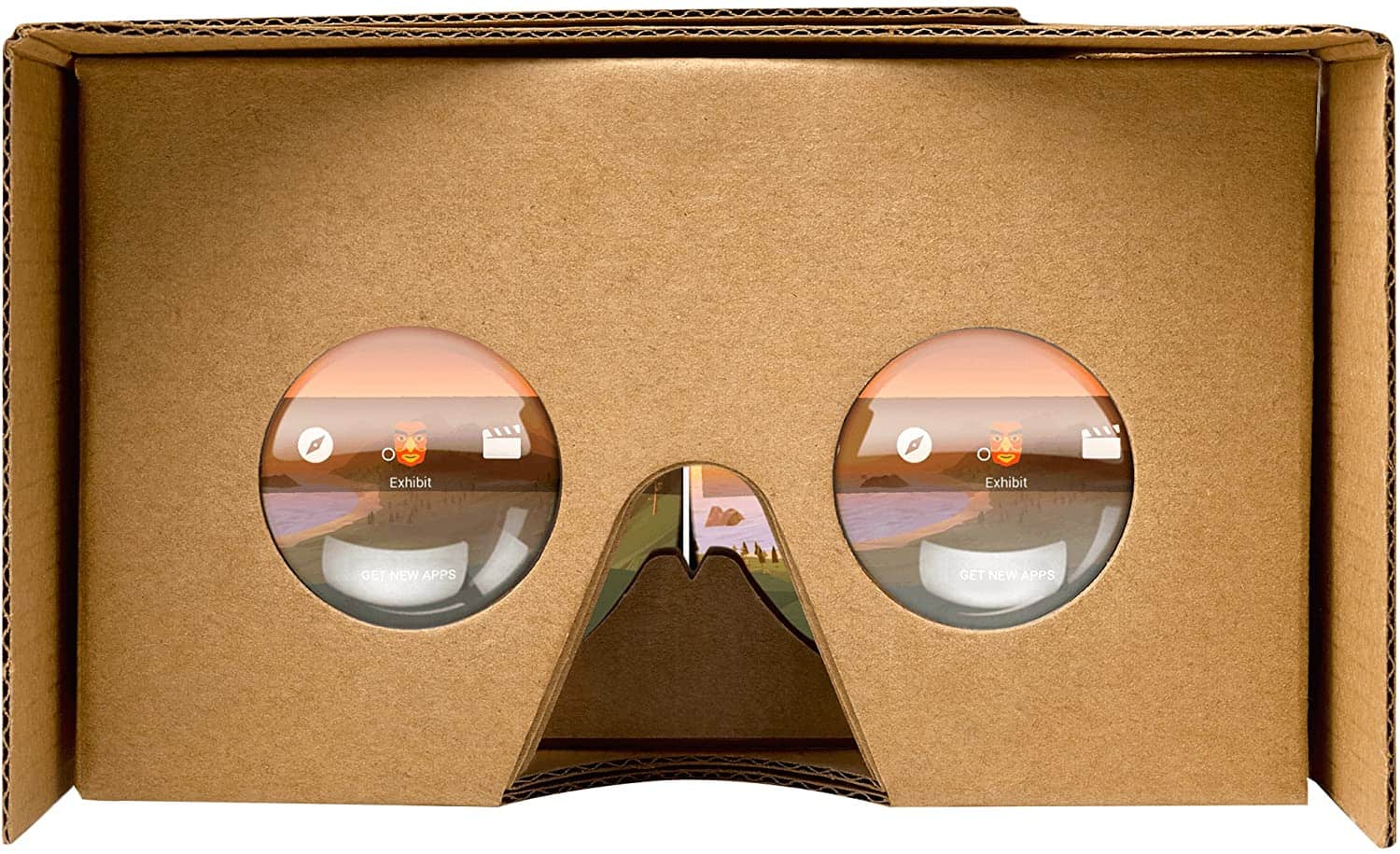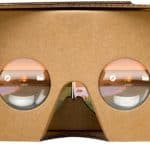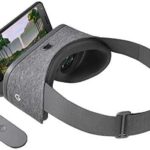Best Google VR Headset

The popularity and advanced technology of VR headsets have turned virtual reality from a sci-fi fantasy into, well, everyday reality! We talk about virtual reality in the same way we would talk about gaming consoles, smartphones, or any other piece of modern technology we would use in our everyday lives.
But people often conflate popular but pricey virtual reality headsets like the Oculus Rift with cheaper alternatives like the Google Cardboard and expect them to do the same thing.
But while the Google Cardboard may not be as advanced as Oculus headsets, there is still a lot to write home about, especially the price! Below, we’ll take a closer look and review Google’s two VR headsets, the Google Daydream and Google Cardboard, as well as a buyer’s guide of what you can expect from budget-friendly VR headsets, as well as answer a few frequently asked questions.
Products at a Glance
Best Google VR Headset
- Extremely budget-friendly: We cannot overstate how inexpensive the Google Cardboard is. It’s definitely the top pick for a VR headset that won’t break the bank!
- Easy to set up: A big part of the Google Cardboard’s appeal is its simplicity, and the fact it’s made out of literal cardboard makes this VR headset incredibly easy to set up.
- Uncomfortable: Naturally, having cardboard on your head isn’t going to be the most comfortable experience. In this regard, the Daydream has it beat.
- Not so interactive: You’re not going to get the kind of immersive or interactive experiences you would expect from the likes of Oculus.
Originally available from the Google Store at around $30 and now available on Amazon for under $10, it’s safe to say the Google Cardboard is the most budget-friendly and accessible VR headset, as well as being a fun DIY project!
Because the Google Cardboard is a very literal product. It’s actually made of cardboard, a couple of lenses, and maybe some tape or velcro (depending on your DIY skills). If you’re a keen DIYer and want a bit more of a challenge, then you can even download instructions to make the Google Cardboard entirely from scratch.
However, if you’re a keen VR enthusiast, then the Cardboard isn’t going to blow you away. To use the Cardboard, you simply have to insert your phone inside. It’s a good way to show VR novices what all the fuss is about, however.
While the DIY VR headsets are hard to get your hands on nowadays, if you can find one it takes about five minutes to assemble. The cardboard is pre-creased and labeled with numbers, and each piece has a corresponding number that tells you exactly where a certain tab needs to be fitted. Most Cardboards come with two lenses, double stick tape, velcro, and a rubber band.
The rubber band is used to keep the phone in place, although the velcro does a good job of this too. When playing more intense games though you may need the extra hold.
There is also a strong magnet with a washer on the side that lets you control the phone. It can only press the phone using the phone’s magnetometer which is usually utilized by your phone’s compass. This is fairly effective, but it’s worth noting this may not work for every phone.
With NFC enabled on your phone, the Cardboard app should automatically launch on your phone once the DIY headset is inserted.
However, using the Cardboard isn’t exactly a hands-free experience. Some users have created their own version of the Cardboard where the velcro pieces have been attached. This keeps the small headset on without having to hold it.
The display of Google Cardboard will depend on whatever phone you own. Smaller Android headsets tend to work better with the small viewer, and devices like the Google Nexus 4, Nexus 5, Moto X, Samsung Galaxy S4, S5, and Samsung Galaxy Nexus are fully compatible. If your phone doesn’t function with the magnet but can still run the apps it will be partially compatible. For example, the HTC One and Moto G. Larger Cardboards will even fit the Nexus 6, Samsung Note 2, Note 3, Note 4, Oneplus One, and iPhone 6 Plus. Android headsets will also require Jelly Bean 4.1 for the most optimal experience.
It may come as a surprise that the Cardboard is also compatible with iPhones! However, this is dependent on the availability of the apps on the platform.
- Comfortable design: The Daydream’s comfortable design gives it the edge over its other VR rivals.
- Unsecure: While it has a comfortable design, it’s not the most secure on your face.
- Lack of apps: The small number of apps makes for a limited experience, especially when some crucial apps are unavailable.
Launched in 2016 and following the HTC Vive, Oculus Rift, and Sony Playstation VR, Daydream was the next step in Google’s VR evolution. The Daydream View was originally designed to work hand-in-hand with Android 7.0 Nougat and Google’s Pixel phones.
Like Cardboard, most of the operations of the Daydream are carried out by a smartphone, with the headset not containing any display or electronics. When it was launched it was only compatible with Pixel phones which made it rather limited.
This was already a problem with Samsung’s Gear VR at the time, which was only compatible with the Galaxy S6 and S7.
One of the best things about the Google Daydream is how aesthetically appealing it is. It is beautifully designed, with a soft, stretchy fabric for a comfortable fit. Unlike some VRs that look very off-putting and uncomfortable, you’ll be dying to wear the Daydream! Some may say it’s too simplistic looking though, maybe even deceptively so. Getting the screen in focus can be quite fiddly, and the rear elastic headband is quite tricky to adjust once it’s on your head. The weight of the phone often weighs the headset down, pulling it down over your nose and can leave the bulk of the headset resting on top of your cheekbones. Another strap at the top of the headset may help to make it more secure.
Slotting the phone in, however, is simple. You just need to unlatch the front of the headset, place your phone inside, and as long as your phone is switched on and unlocked, it will automatically switch to the VR headset. Then, just pop the catch back in place and you’re ready to go! It doesn’t exactly look elegant once the phone is inside it, and we would recommend not using the Pixel XL as it may be too big to be completely contained within the headset. The elastic catch may wear out after a while too.
However, once everything is set up and sitting correctly on your face, you’re sure to be impressed. The optics are definitely an improvement from the Google Cardboard headset, and the 2,560 x 1,440 AMOLED display on a Pixel phone totally compliments the headset. It delivers superb, rich, and vibrant scenes that are also sharp and crisp. You’ll probably notice some motion blur when you move your head from side to side, but not enough to make you feel nauseous.
Another great aspect of the Daydream is its bundled remote. You can tell Google has taken note of what needed to be improved or added since the Cardboard and this certainly delivered. The Daydream View remote works a lot like a Wii Remote on your TV. You simply hold it in your lap and use its variety of motion sensors and touchpads to navigate the virtual worlds. Much like a Wii Remote, it also comes with a wrist strap so you don’t lose the remote or accidentally hurl it across the room. We’ve all been there with our Wii Remotes!
You’ll find three buttons on the remote. A home button, a menu button, and a large, circular touchpad for clicking, scrolling, and interacting with apps and games. This works extremely well and can be set up for both right or left-handed use. It’s hard to lose the Daydream View remote too, as it comes with a small recess and elastic band in the main flap where you can store it.

Best Google VR Headset

Best Google VR Headset
Buyer’s Guide
As we’ve mentioned a couple of times already, what sets Google’s VR headsets apart from the rest is their affordability – especially the Cardboard.
However, if you’re new to the world of VR you may be wondering how you discern your Oculus Rifts from your Cardboards, and if you’re looking for an inexpensive option you may be wondering what you can expect from your budget.
In our buyer’s guide, we’ll break down what you’ll be able to do in the less expensive side of virtual reality, what the price ranges are, and what features you can look out for. Before you buy, it’s also important to decide what exactly you’re looking for from your VR headset. By this we mean do you just want to dip your toe in with the simplest tools available?
Then Google’s budget-friendly options may be for you. However, if you’re looking for the best VR experience possible then we suggest holding out for the more expensive options. They’re pretty sure, but totally worth it.
Design
The Google Cardboard has introduced us to the simplest form of virtual reality yet. A pair of magnifying lenses and a sheet of cardboard, using a standard smartphone as a screen.
However, this idea has been around for years. Long before Google branded it! But what truly is innovative is the amount of work Google has put into best practices that manufacturers can follow to get an official “Works with Google Cardboard” stamp of approval.
It’s worth noting that not all budget headset makers follow these practices, but the most readily available sets are compatible with Cardboard, meaning they’ll also work well with similarly certified Android and iOS VR apps.
Cardboard-compatible headsets, some made of plastic or even aluminum are easy to get. However, they have limited interactivity and are more suited for watching 360-degree videos. They’re also not meant to be used for long periods of time. While Cardboard headsets are pretty uncomfortable, ergonomic plastic alternatives like the Mattel View-Master are only comfortable to wear for about five minutes at a time too.
Smartphone Compatibility
All you need to have to use a Google Cardboard is a smartphone – something most of us have. This is great news if you don’t want to upgrade to a brand-new device. As we previously discussed, even iPhone users can get in on the fun!
However, Google is known for delaying new Cardboard features to the iOS version of apps like YouTube. Apple has been fairly quiet on the VR front, but rumors have been swirling that they could release a high-quality mobile experience to rival the Samsung Gear VR.
However, if your phone is particularly old, it’s not guaranteed that it can handle Google Cardboard apps well. And if it is compatible with the Cardboard, you may find you receive a low-quality and laggy performance.
Portability
The Google Cardboard is one of the most portable headsets around, while some of its contemporaries are not. The basic Cardboard shape folds into a stackable box, and the smallest Cardboard design is about the size of a pair of sunglasses!
However, making a Cardboard-style headset more portable usually means making it less comfortable, as well as less immersive. But even if you can’t take your headsets everywhere, headsets are usually better enjoyed inside on a spinning chair.
Controllers
To be fully Cardboard-compatible, a headset needs to have just one input. That doesn’t necessarily have to be a button. The simplest headsets on the market are just boxes and lenses with a hole for one finger or thumb that lets you tap the screen directly. The headsets that do have buttons are usually little levers that press the screen for you.
You may be thinking that one button leaves you with limited options and well, in a way you’re right. With one button you can only really select options on a menu, or perform simple and relatively slow actions in a video game.
Still, some Cardboard apps do not require the use of a button. In fact, with some apps, all you need to do is stare at a menu for a second or two to select it, or move your head to change direction in a video game – pretty cool!
Is Google Cardboard discontinued?
Unfortunately yes, the Google Cardboard is discontinued. In March 2021, Google stopped selling the Cardboard VR on the Google Store. It was the final phase of Google’s plans to wind down its once ambitious VR projects. Customers visiting the store will now see a message stating: “We are no longer selling Google Cardboard on the Google Store.”
However, hope is not lost for the Cardboard as it is still available on Amazon.
Is Google Daydream discontinued?
Unfortunately, Google Daydream is also discontinued. In October 2020, Google officially dropped Daydream virtual reality support from Android 11, which was the final phase in retiring the system. Google announced its latest version of Android does not support Daydream’s app, saying “Daydream VR app is no longer supported by Google and may not work properly on some devices running Android 11 or later.”
Now Daydream software is no longer supported at all. It’s stopped receiving updates, although you can still potentially access third-party VR apps through the Play Store. Plans for discontinuation for the Daydream View headset began in 2019 when it dropped support for it on new Pixel phones. But it continued to support the Daydream app for existing users.
However, you can still find Daydream on Amazon.
What is the best VR headset?
Our pick for the best VR headset would be the Oculus Quest 2.
With the Oculus Quest 2, you don’t need to fiddle with smartphones or buy an expensive gaming PC to experience high-quality VR. Just set up the comprehensive all-in-one VR experience and enjoy some VR without the safety hazard of tripping over cables, or worrying about your smartphone battery dying.
There is still the option to connect the Quest 2 to a PC, and that is still a great way to play Oculus-supported games. Furthermore, there are sure to be even more impressive updates to the Quest 2 soon!
For the best VR experience, you will need a VR headset that’s connected to a powerful PC. For that, we would recommend the HTC Vive and Valve Index. These headsets do require a lot of space to be fully effective, especially if you want to do room-scale VR.
However, if you would rather experience VR on a PS4 or PS4 Pro then the PlayStation VR is a good option. It’s simple to set up, so you’ll be playing games like Batman: Arkham VR in no time! Remember though that you will need a PlayStation Camera to use it, and bear in mind that it won’t be a seamless experience with a PS5.

